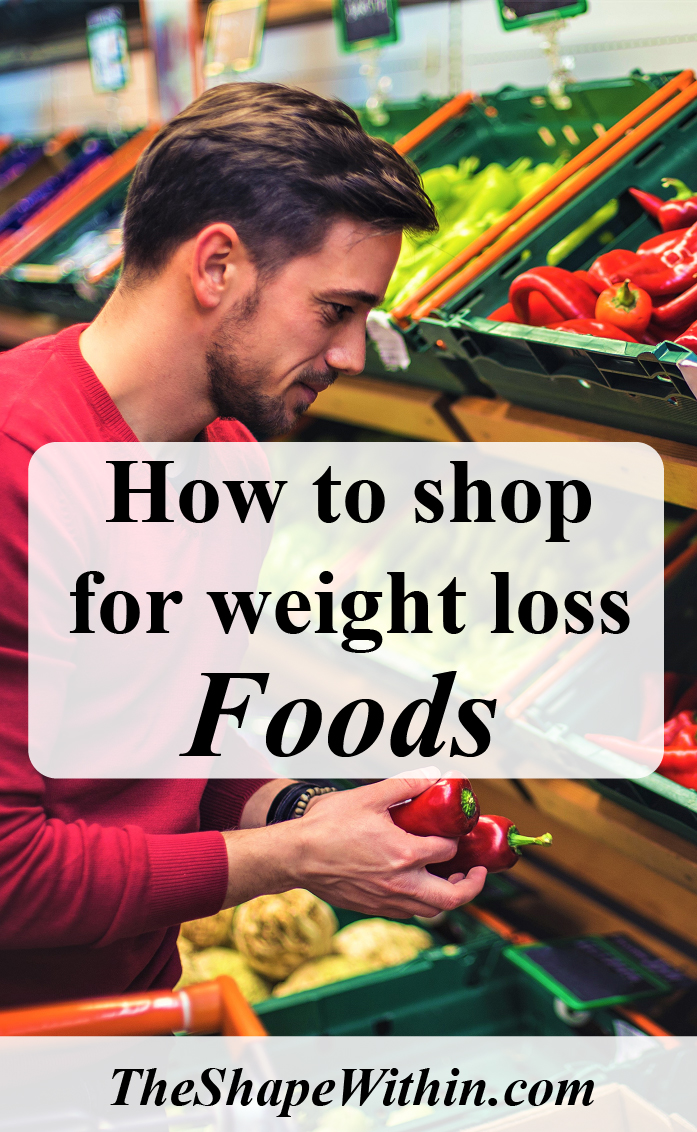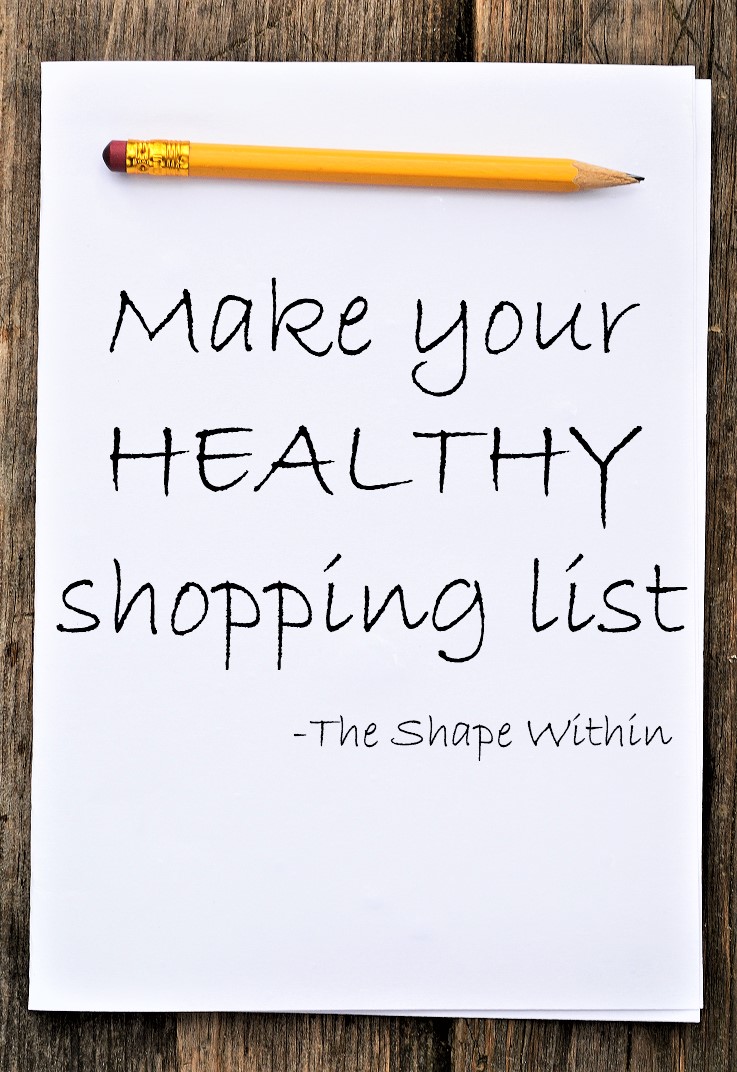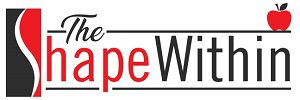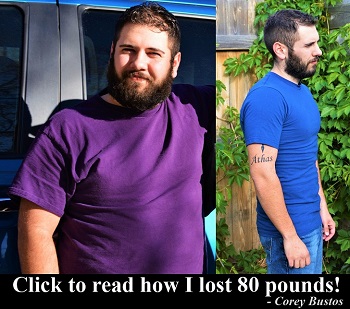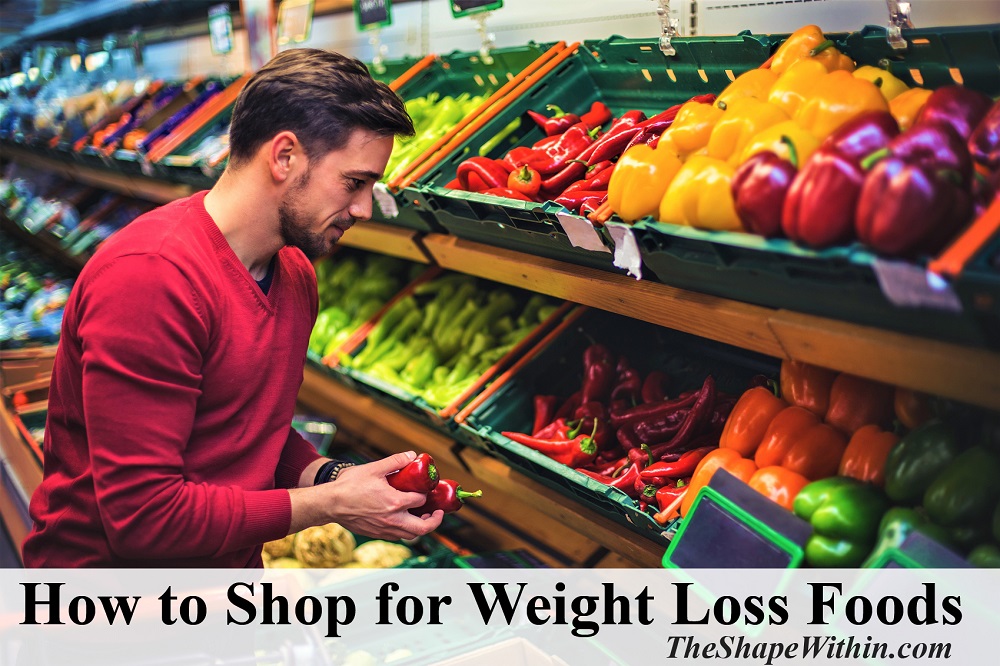
Going to the grocery store blindly when you are excited about starting a new diet can often result in leaving the store with too many of the same things you normally buy, and too few of the healthy items that you wanted to find.
You may tell yourself that you’ll know what to buy as you walk around and look at all of the options, but you may find that the store isn’t a great place to plan your diet, and make tough decisions.
However if you spend a little time creating a healthy shopping list for weight loss before you go to the store, you are much more likely to be successful. In this article I will help you to understand what kind of foods will help you lose weight, and which will not.
Finding healthy foods you like is something that takes time. As you start making healthy changes, getting in shape, cooking, and going back to the grocery store repeatedly… you will get new ideas, and discover new things that you like.
Don’t expect to find everything that you like in one trip, because as you progress through your journey you will constantly discover new healthy foods that you love.
Below is a food pyramid that I have made, which separates food by how healthy it is in terms of weight loss, rather than by nutrient group as in a traditional food pyramid. Let’s take a quick look at this so you can get an overall idea of what types of items are healthy, and which are not.
The Weight Loss Food Pyramid
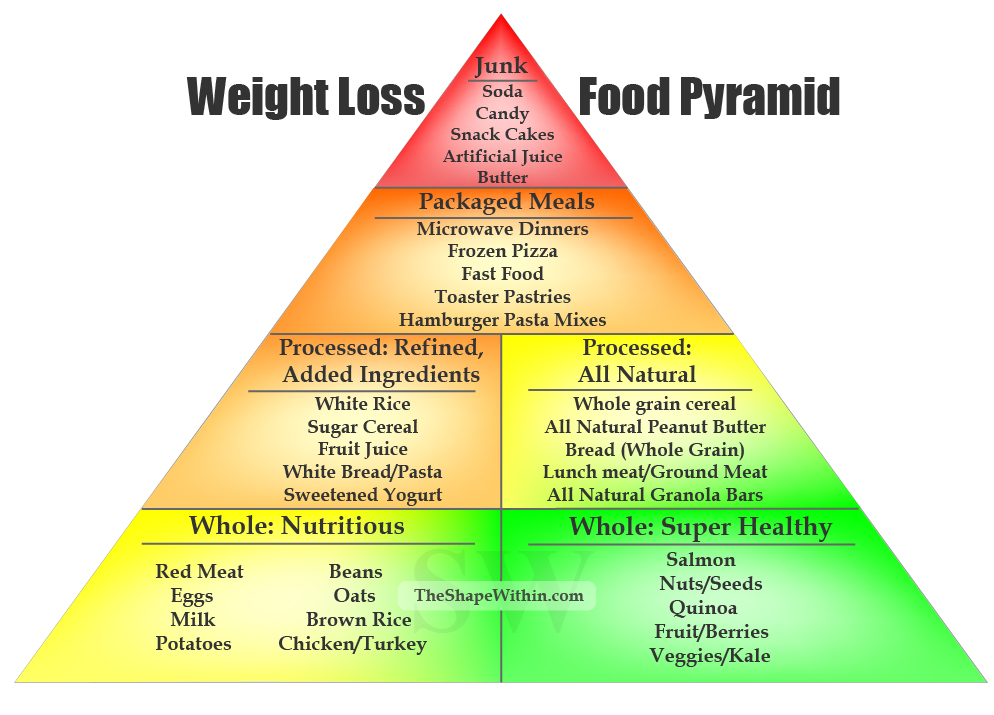
Red– Has little or no nutritional value and has tons of bad fats, and sugar/carbs.
Orange– Has some nutritional value but still has lots of bad added ingredients.
Yellow– Is nutritious but is not necessarily super healthy. Can be a good weight loss option if eaten in moderation.
Green– Extremely nutritious and healthy, eat freely and lose weight.
This is obviously a completely different way of categorizing food, but it is an extremely effective way of both thinking and shopping while losing weight. As mentioned earlier it will ultimately be up to you to find healthy foods that you like, as the foods in each category above are just a few examples.
There are many more options in each food group that I will not have listed in the examples, and so don’t be afraid to take your time at the store now that you will know what to look for. By the end of the article you should have a strong idea of what is healthy, lots of healthy items listed, significantly less unhealthy foods on your list, and the confidence to know that these changes will make a difference.
However, though this weight loss pyramid organizes only by health benefit and mixes different traditional food groups together, it is still extremely important to still be mindful of eating a diet with a healthy balance of nutrients. You will find more foods that you like as you go along, but to set yourself up for a successful healthy diet, be sure to buy a variety of healthy foods (Fruit, Protein, Vegetables, Grains… etc), but be sure to buy lots of fiber and protein foods.
Especially when losing weight, a large portion if not the majority of the food you buy should be protein, which makes sense but without hearing the fact outright it can be strange to buy so much from one food group at the store. Load your basket confidently with lean meat and leafy greens.
In this article I will explain each of the categories of food shown above in detail, so that you know what to look for and how much to buy when you go to the store.
There will of course be exceptions to these categories, as not every food is so easily defined. For example, dark chocolate can actually be eaten in small amounts to control appetite and bring balance to your diet. It is nutritious (has fiber, antioxidants and vitamins), and is very filling.
When in question about the healthiness a certain food, use your best judgement with what you learn here today. Ask yourself what the food derived from, how much it was processed, and what ingredients were added.
Reducing unhealthy foods
Before you go to the store, you should get a realistic idea of what you are not going to buy so that you can have a plan to hold yourself accountable to at the store.
Sugary Junk Food
I tend to consider most packaged foods to be junk which I will discuss here soon, but for now we’re talking about reducing sugary junk food… Candy, Ice Cream, Snack Cakes, Soda… etc.
There are very few items in the junk category that can be traded for a healthy version as the food in the red zone have little to no nutritional value. But an example of an exception to that statement would be trading sweet tea for natural green tea, or artificial juice for all natural juice with no added sugar or high fructose corn syrup.
A simple trade for an all natural version of a food or drink can make a huge difference. As you saw in the example and picture above, choosing a healthy juice over an artificial one brings it from the red zone to the yellow/green. I will talk about this more when I discuss the processed/refined foods portion of the pyramid, where most of your healthy replacements can be made.
So there will be a lot of people who read this, all with different habits and lives, and there’s no way that I could say to buy a certain amount of food in each category that would work for everyone, and so it will be up to you to evaluate how much junk you buy and consume normally, and to reduce it according to the suggestions below.
Write down all of the junk food you would normally buy, and cross off at least two of every three items. If you want to go all out, don’t go for perfection (yet). Consider allowing yourself one drink item and one food item of junk food and leave it at that.
Instead of feeling bad when you cross off items or pass them in the store, be excited that you are doing things right and know that the decision will pay off in the near future.
It is important to know that even though you will naturally reduce the junk you are eating by purchasing fewer items, you still need to consume less of those items when you get home. Make them last longer. Don’t just buy more boxes of that one thing to make up for the other stuff you didn’t buy. Again, if you ate 3 snack cakes or drank 3 sodas per day, have 1, if you only had 1 per day in the first place then have a few per week. The point is to make a big change that will bring on a large result.
I stopped buying snack cakes, ice cream, toaster pastries, sweet tea, potato chips, sugared cereal, and sugar itself. I will sometimes indulge at work or with family, but this is nothing compared to having junk food at home all of the time and eating it in excess every day.
If you come across something unhealthy that you MUST have that you didn’t think of while building your healthy grocery list from home, replace it with another junk item. Be wary of making exceptions for junk while shopping, as one will often lead to another until you are not giving yourself a fair chance.
Packaged Meals
Okay, so lets talk about unhealthy food that is not typically considered junk food, such as the packaged foods that most people make most of their meals out of. These foods, though they are not quite as fatty as cakes and candies, are often the largest part of people’s diet, and are extremely important to replace to the extent that you comfortably can.
Examples of these foods that I no longer buy are chicken rice packets, hamburger pasta mixes, frozen pizza, waffles, packages of pre-cooked and breaded chicken, TV dinners… the list goes on. These foods are usually all within the same aisles, and cutting these foods out of my diet often means skipping 3-4 aisles in the store almost completely. There are of course exceptions, but for the most part, if I see frozen, boxed, canned, or packaged meals, I skip the aisle.
It still surprises me that almost everything I used to live off of is no longer a part of my diet, but nothing in the packaged meal section can’t be made at home with healthy ingredients and a little patience. However I am not asking you to cut all packaged meals, I am asking you to make a dramatic change while keeping one or some of them in your life.
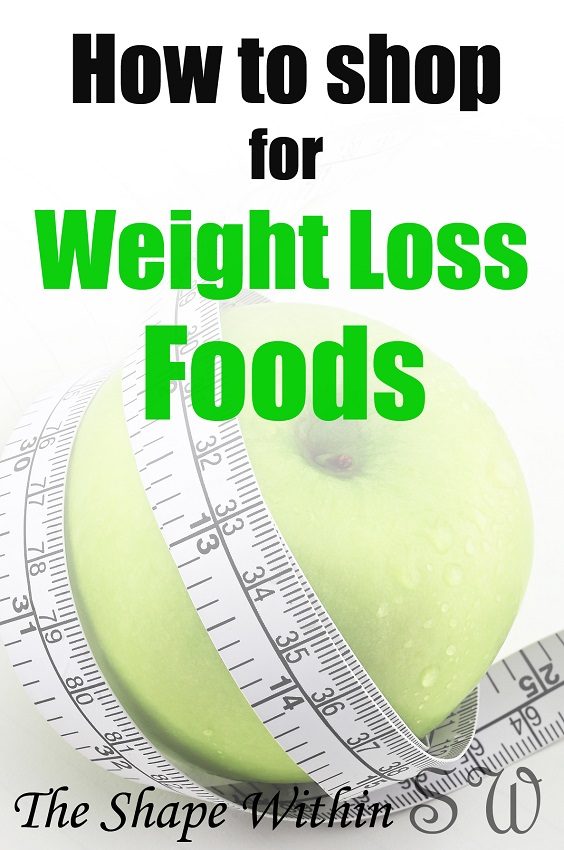 It may not seem like these are so unhealthy because they are what many would call “food food,” and they actually will provide you with the nutrients you need, but they are also packed (to a disgusting amount) with bad fat, sugar, high fructose corn syrup, and unnecessary amounts of carbs.
It may not seem like these are so unhealthy because they are what many would call “food food,” and they actually will provide you with the nutrients you need, but they are also packed (to a disgusting amount) with bad fat, sugar, high fructose corn syrup, and unnecessary amounts of carbs.
I won’t talk about reading labels until we get to the next section, because packaged meals for the most part are what they are and can’t be traded for all natural versions.
This is where you find misleading labels that make you think you’re being healthy but you’re not. Low fat/low sugar versions of these packaged meals are just not going to make a big difference if at all, so simply buy fewer of these items as well and don’t worry about reading labels here.
Follow the same guideline as in the junk food section, write your normal list, and cut out anywhere from 2/3 of these items, to all but 1, but not all of them. This may be one of the hardest sections to cut back on as it makes up such a large part of our diet and these meals are incredibly convenient.
This is where you may start to notice that a lot of the food you will be buying will be raw, whole, and must be cooked yourself. This is the way it should be when you are truly buying healthy foods. This, is what will lead you to losing lots of weight without being hungry or needing to count calories.
People so often feel that it will take perfection and immense effort to lose any weight at all, and this is just not true. You can make a huge difference in the beginning by having far less than a perfect diet, because the reality is that so many have nowhere to go but up with their eating habits.
It used to be that the only limit I had when I went to the store was how much money I had and how much the basket held. Again, as soon as you get to the store and start wanting more than what was planned, stick to the plan and follow the list.
Now that the sacrifices have been made and the hardest part is out of the way, you can truly start to build your shopping list with healthy food and know that you’re not going to fall into old habits when you go to the store this time.
Processed/Refined Foods, And Reading Labels
If you look at the pyramid you will see that this whole category spans from the orange zone all the way up to green.
Processed and refined foods have been altered in some way from their whole and natural version, which can completely change whether a food is good for you or not.
Examples of processed foods would be lunch meat, bread, peanut butter, jelly, and juice. These all derive from whole and natural foods, but have been significantly altered. The extent to which these foods were changed is up to us to investigate when we are at the store.
There are many healthy replacements to be found within this category, as many companies make a version of your favorite foods that have been minimally processed, are unrefined, and have no added artificial ingredients. A little label reading and careful selection will be the difference between leaving the store with something that will help you, or hinder you.
Refined foods- like white bread and rice
To make this whole section much more simple I will mostly stick to label reading, but here is a quick note on grains and refinement.
Below we will be talking about finding healthy replacements of foods in the orange zone by making sure that they have no added artificial ingredients, and though you can find bread/rice with no added ingredients, when it comes to making a healthy replacement with a food made from grain the most important thing before worrying about added ingredients as discussed with other foods below, is buying the whole grain or wheat version. Here is why.
Grains that have been refined or that are “white”, have been literally stripped of their most healthy qualities, meaning that what was once nutritious, is now closer to empty calorie. A seemingly simple change that we often see as simply a change in color, completely changes the nature of the food and reverses it’s weight loss benefits.
White rice for example, has been stripped of its outer layer, which takes away its protein and fiber content and allows the grain to turn quickly to sugar and then fat in your stomach, instead of giving long-lasting energy throughout the day that allows your body to burn fat.
Though changing from white bread to whole grain will take you from the orange zone to the yellow, going from white rice to brown rice will take you all the way to the green super food zone, as brown rice is whole and has not been processed.
If you compare the nutrition label for white vs grain bread, you will often find that each serving of the white product has nearly zero fiber and protein, where the whole grain version may have several grams of each.
Processed foods- What to look for on labels
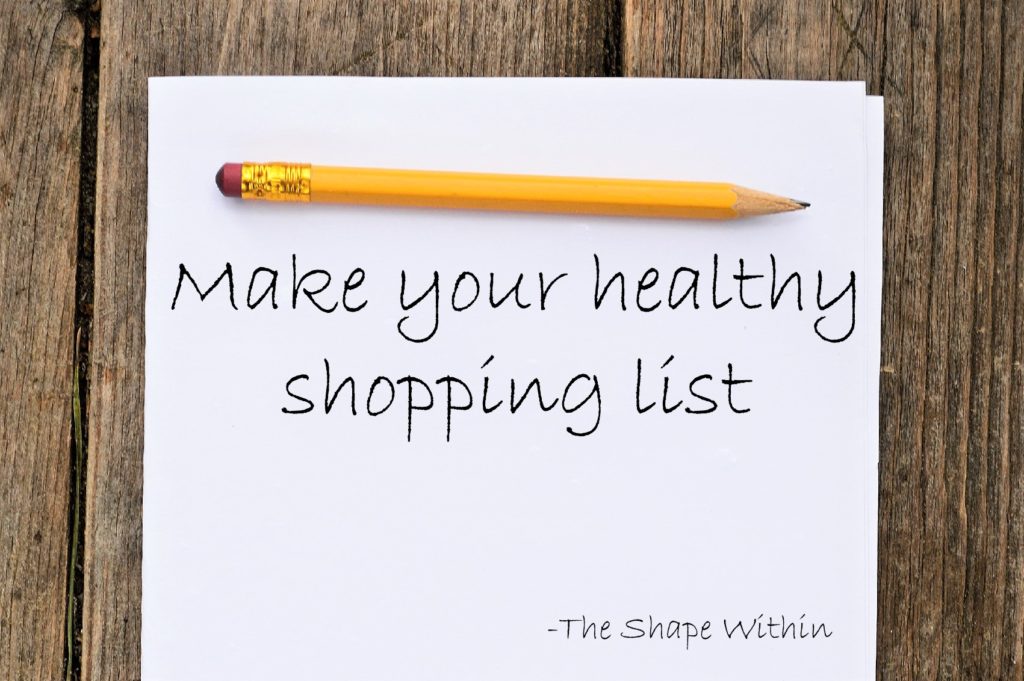 You may notice on the pyramid that foods with added ingredients like sugar and high fructose corn syrup also remain in the orange zone, along with refined grains. This is because these foods will turn to fat right away and work against you because they have added artificial ingredients.
You may notice on the pyramid that foods with added ingredients like sugar and high fructose corn syrup also remain in the orange zone, along with refined grains. This is because these foods will turn to fat right away and work against you because they have added artificial ingredients.
But the good thing here is that there are many healthy replacements to be found within this category of foods, often by simply buying an all natural product made by the same name brands you are used to. The downside to this is often price as you will not just be able to buy the cheapest item, but in my experience all natural versions taste better and of course have played a large part in losing lots of weight.
One of my favorite moments while weight loss shopping was the completion of a healthy PB&J sandwich. When I had found an all natural option for all three ingredients (which is easy to do at a large store), it was a trifecta that added one of my favorite snacks to my weight loss options. Although PB&J are closer to the yellow zone of the pyramid than the green zone, when made with all natural ingredients they can be eaten in moderation to replace junk foods. Even though they do digest quickly, they have protein, healthy fat, fruit, grains, and therefore balance.
After I knew what to look for on labels, I was surprised to find that there were so many name brands with healthy options that had been right in front of me. Or perhaps I had seen them before and thought, “why would someone buy that”, not knowing it was free of the ingredients that turn straight to fat.
One of the first places people look on a food label is the nutrition facts, and this of course would seem the most logical place to look when concerned with weight loss. The nutrition facts are not always the best indicator of how healthy a certain food is, and they are certainly not the first thing you want to look for when making a healthy selection of processed and refined foods.
You likely will not know what is available in all natural versions until you get to the store, and so here is how to find them when you are there with your list.
If you are making a healthy trade, the best thing to look for are the qualities listed below, which companies will usually advertise proudly on the front, back, or side of the product. There are some companies/foods that are known to be healthy and do not even advertise this, and so you may need to read the ingredients.
All Natural– This will often be in large print, and is something that should grab your eye right away. This means that the food does not have artificial flavors or ingredients, and that it has been processed very little, which usually means that the food is at least in the yellow zone of the pyramid, as these foods all stem from whole foods in the green zone.
The label will almost always explain what it means by “all natural,” usually with most or all the listed qualities below. You can also find lots of items that advertise these qualities but that do not specifically say that it is all natural.
No high fructose corn syrup
No sugar added
No artificial flavors
No artificial ingredients
These added ingredients and flavors, especially the artificial ones, are the silent killers of your diet that turn foods which are inherently healthy into something that will make you fat. But now you know how to cut through the crap, and buy versions that don’t carry any extra baggage.
You may find it easier than you think you find a healthy replacement for almost all of foods in this category.
Whole foods and super foods
And so now we come to the most important and powerful category of foods, which is whole food!
Some of the foods in this category are still in the yellow zone, as they are not quite as lean as the others. For example, nuts are very nutritious, but still high in calories so should be eaten in moderation.
Try to find lot’s of green zone foods that you enjoy, as they will help you to naturally rid your cravings for sugary foods, and lose weight without having to be hungry. Eating more lean and nutritious food means losing more weight. Whole foods will satisfy you and sustain you while letting your body remain in a calorie deficit, and burn its own store of fat.
Your basket should be heavy with protein, but you should also aim for finding a variety of foods in the whole food category such as fruit, meat, vegetables, etc… Balance is key when satisfying your hunger without overeating. A quick note… yes you need carbs, just buy healthy grains and reduce them a bit, not eliminate.
You will be amazed at how easy healthy shopping can be when you go to the store with a prepared, healthy shopping list for weight loss… and you will be excited to start getting in shape when you finally have everything you need to succeed right in your own cabinets.
If you want a diet plan you can follow to make sure you take action and keep making progress, try the 8-Week Weight Loss Challenge!
Want to know more about how I changed my eating habits to lose 80 pounds? Read about the foods that I ate to lose weight.
